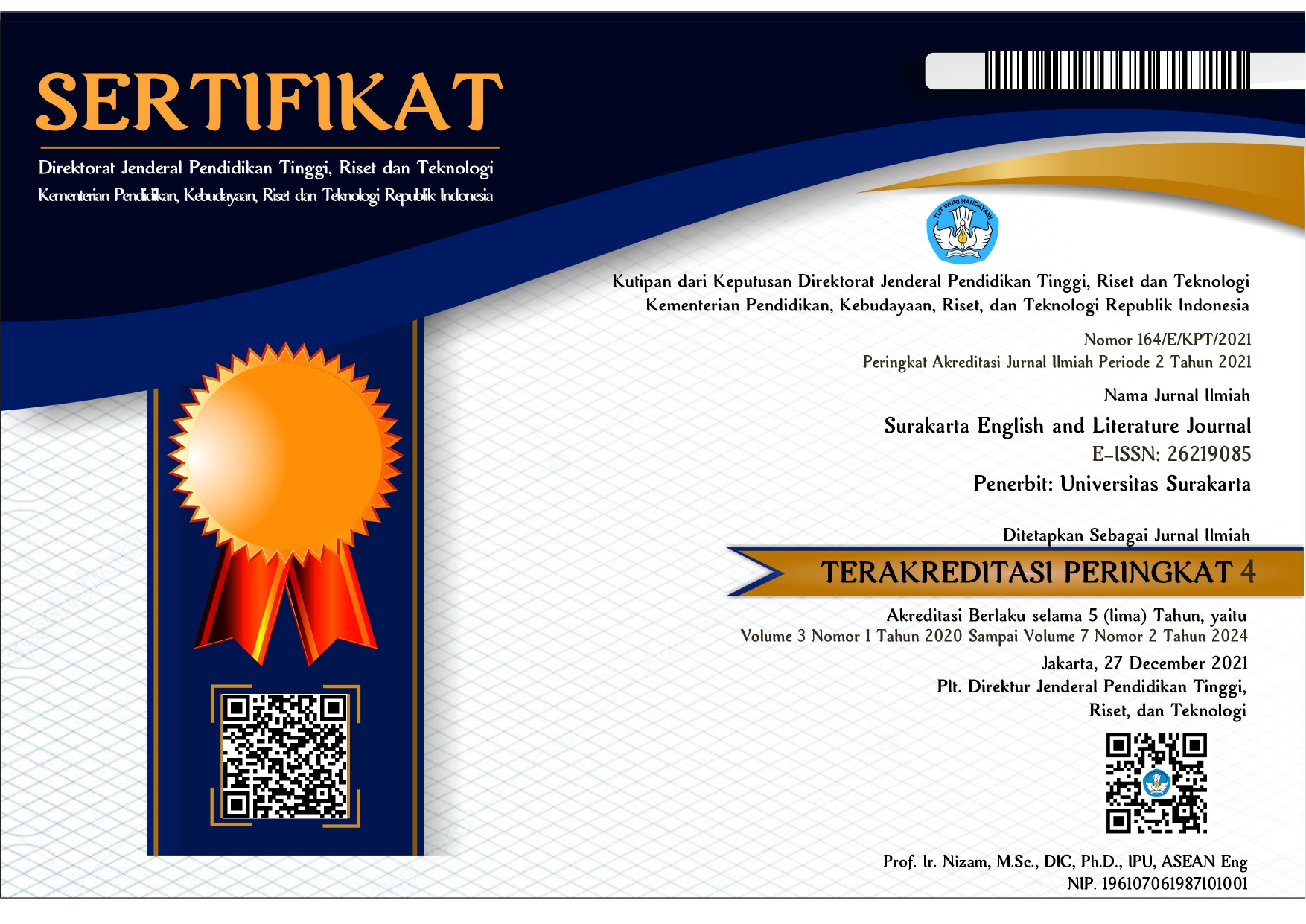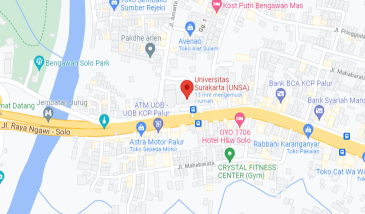The Profile of Undergraduate Students' Ability in Writing Exposition Text
DOI:
https://doi.org/10.52429/selju.v7i1.191Keywords:
Analytical Exposition Text, Writing Ability, CEFRAbstract
This study was aimed to identify the ability of first-semester students' class of 2023/2024 in writing analytical exposition texts according to CEFR level at UNK Semarang and identify the problems faced as well as solutions to these problems. The data were taken from 35 students' writing products and the results of interviews with several students. Data analysis for assessment writing will use Ratnaningsih' theory and CEFR. This research uses mixed methods, in the first stage the researchers will carry out a quantitative method first (calculating writing test scores) and then the researchers will carry out a qualitative method (interviews). The results of this study showed that the writing skill level of participants is at level C1, where the highest aspect obtained by most students is content and the lowest aspect is mechanics. Apart from that, the main problems in writing analytical exposition text are grammar, vocabulary, spelling, punctuation, and capitalization. Lastly, researchers can propose for the problems in this study is to increase or diligently practice writing in English, note down a new vocabulary that has never been known before and increase knowledge with various kinds of references found, for example from YouTube.
References
ALQAHTANI, M. (2015). The importance of vocabulary in language learning and how to be taught. International Journal of Teaching and Education, III(3), 21–34. https://doi.org/10.20472/te.2015.3.3.002
Annisa. (2018). Students’ Ability in Writing an Analytical Exposition Text at English Department of Universitas Negeri Padang.
Brown, H. D. (2017). Language Assessment Principles and Classroom Practices. Pearson.
Council, B. (n.d.). English levels. 2023. https://www.britishcouncilfoundation.id/en/english-courses/adults/levels
Creswell. (2009). Qalitative, Quantitative, and Mixed Methods Approaches.
Creswell, J. W. (2014). RESEARCH DESIGN Qualitative, Quantitative, and Mixed Methods Approaches.
Esterberg. (2002). No Title.
Europe, council of. (2001). COMMON EUROPEAN FRAMEWORK OF REFERENCE FOR LANGUAGES: LEARNING, TEACHING, ASSESSMENT.
Febrianto, A. R. (2021). The Academic Writing Performance of Novice EFL Student Teachers. ELECTRUM, 1, 14.
Framework, C. E. (2018). Companion Volume. In New Cambridge Modern History (Vol. 13). http://universitypublishingonline.org/cambridge/histories/ebook.jsf?bid=CBO9781139055895%5Cnhttp://www.cambridge.org/ca/academic/subjects/history/european-history-general-interest/new-cambridge-modern-history-volume-13?format=HB
Irwan, A. F., Syafei, A. F., & Marlina, L. (2018). Students’ Ability in Writing an Analytical Exposition Text at English Department of Universitas Negeri Padaing. Journal of English Language Teaching, 7(1), 169–176.
KARTIKA, L. A. (2019). AN ANALYSIS OF THE STUDENTS’ ABILITY IN WRITING DESCRIPTIVE TEXT AT THE SEVENTH GRADE OF MTS SUNAN AMPEL PARENGAN TUBAN. 25.
Leksono, M. L. (2019). Analisis Kesalahan Penggunaan Pedoman Ejaan Bahasa Indonesia (PUEBI) Pada Tugas Makalah dan Laporan Praktikum Mahasiswa IT Telkom Purwokerto. JP-BSI (Jurnal Pendidikan Bahasa Dan Sastra Indonesia), 4(2), 116. https://doi.org/10.26737/jp-bsi.v4i2.1106
Maulidina, P., & Wibowo, H. (2022). the Use of Grammarly Tools To Enrich Student’S Writing Ability. Lingua, 18(2), 179–189. https://doi.org/10.34005/lingua.v18i2.2246
Nurhamdah, H. M. (2020). An Analysis of Students’ Ability in Writing Analytical Exposition Text. LETS: Journal of Linguistics and English Teaching Studies, 8.
Nurmalia. (2018). An Analysis of Students’ Ability in Writing Analytical Exposition Text at the Eleventh Grade of Senior High School 9 Pekanbaru.
Permatasari, A. D. (2018). ERROR ANALYSIS ON EFL LEARNERS’ ANALYTICAL EXPOSITION WRITING. SURAKARTA ENGLISH AND LITERATURE JOURNAL, 1, 9.
Prof.Dr.Sugiyono. (2011). Metode Penelitian Kombinasi (Mixed Method) (M. T. Sutopo (ed.)). ALFABETA, cv.
Prof.Dr.Sugiyono. (2018). METODE PENELITIAN KUANTITATIF KUALITATIF DAN R&D (M. Dr.Ir.Sutopo, S.Pd (ed.)). ALFABETA, cv.
Ratnaningsih, E. (2016). IMPROVING STUDENTS’ WRITING ABILITY THROUGH THE USE OF DICTOGLOSS TECHNIQUE. 12, 14.
Reski, R., Nurhaspia, N., Uswatunnisa, U., & Adawiah, R. (2021). Analysis of Students’ Ability in Writing Analytical Exposition Text. LETS: Journal of Linguistics and English Teaching Studies, 3(1), 23–30. https://doi.org/10.46870/lets.v3i1.88
Rizka. (2022). Students’ Ability in Writing Analytical Exposition Text on Second Grade at SMAN 1 Tembilahan.
Sugiyono. (2012). Buku Metode Penelitian Pendidikan Pendekatan Kuantitatif, Kualitatif, dan R&D. Alfabeta.
Susan Stainback. (1988). No Title.
Zuliani. (2021). An Analysis of Students’ Ability in Writing Analytical Exposition Text.
Downloads
Published
How to Cite
Issue
Section
License
Copyright (c) 2024 Silvy Permatasari

This work is licensed under a Creative Commons Attribution-ShareAlike 4.0 International License.
Licensing for Data Publication
-
Open Data Commons Attribution License, http://www.opendatacommons.org/licenses/by/1.0/ (default)
-
Creative Commons CC-Zero Waiver, http://creativecommons.org/publicdomain/zero/1.0/
-
Open Data Commons Public Domain Dedication and Licence, http://www.opendatacommons.org/licenses/pddl/1-0/














